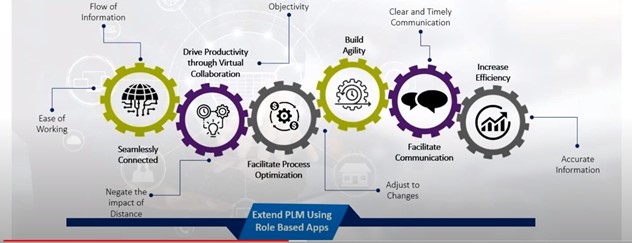
The COVID-19 pandemic has created a massive shift in the way we work. With social distancing and frequent lockdowns to contend with, a large portion of the global workforce is operating from home. In the US, 58 percent are working remotely from home,[i] a clear reflection of the distributed nature of work that will dominate the future. Fortunately, most enterprise and other systems today can go virtual. Distance doesnt matter. The Tour de Suisse, a bicycle race, has gone virtual with shades of Mixed Reality (MR)[ii]–and if that doesnt surprise you, heavy duty mining equipment in Australia has been operated by experts sitting 1,500 km away, in the safety of their offices, for a few years now.[iii] The mining teams can just as easily do this sitting at a desk at home. If such a vast variety of roles and operations can go remote/ virtual, why should Product Lifecycle Management (PLM) be any different?
PLM has already helped organizations cut down costs and has enabled faster creation of innovative products. Now, as COVID-19 wreaks havoc across the globe, PLM can rise to the rescue of organizations operating in industries such as Manufacturing, Consumer Packaged Goods (CPG), Retail, Life Sciences, etc. PLM applications are more critical today than ever before because they can help businesses rapidly adjust their production lines to meet changing customer needs.
The problem is that PLM has its roots in manufacturing with a closed set of users. The challenge is twofold: one, to extend PLM so it goes beyond the engineering team and becomes available for collaboration with other functions like manufacturing, quality, procurement, services, sales and marketing and the leadership as well; two, PLM was designed to manage product lifecycle integrating with upstream CAD and downstream ERP systems, however today it needs to integrate with new technologies like Mobility, Advance Analytics, Internet of Things (IoT), Automation/ RPA, Augmented Reality (AR), Virtual Reality (VR) and Additive Manufacturing etc.
Industries where PLM implementation is mature can easily make the necessary changesthis means an industry like Automotive and Transportation where 23.8% have adopted PLM or Industrial Equipment where 20.2% have adopted PLM can be first movers and lead the way.iv Forecasts suggest that industries such as Life Science, Consumer Goods and Retail will increase adoption, with PLM growing at the highest CAGR of around 8% across these industries. v These industries too should adjust their PLM strategies to become future ready. With technology partners, who are well versed in PLM implementations, this is not difficult to achieve.
A well-known business specializing in performance running shoes and athletic wear, based in Seattle, makes a good example of how even mid-sized companies can update their PLM quickly so they can continue to respect the health guidelines and social distancing norms imposed by COVID-19. The organization’s complex processes require designers to work with new materials and for teams to test these designs before they go for production. To do this, the organizations has incorporated 3D design and modelling into its PLM processes. Its designers use high resolution images of materials to create new products, cutting down on the need for sample requirements.vi Their real-time data platform and modern UIs, integrated with PLM, are at the core of better collaboration between teams that manage schedules, plans, sourcing, design, testing and design approvals for productions. Step-by-step they have overcome the limitations imposed by COVID-19. Now, they even have role-based applications to extend the ability of their PLM. These apps cater to the needs of individual users, improving collaboration, productivity, and agility (see figure below).
|
Improving productivity, efficiency and business agility by extending PLM with roles-based applications
|
||||
|
Mobility Apps |
Automation Apps |
Process Apps |
Reporting Apps |
Tracker Apps |
|
Provides flexibility to work from anywhere, over any device. Users can capture images and share across functions |
Replaces repetitive tasks with RPA to provide 20 to 25% faster resolution for service requests |
Creates end-to-end business processes to improve turnaround time |
Provides end-to-end visibility and facilitates faster and more accurate decision-making by leveraging analytics |
Enables status updates, helps identify bottlenecks and reduces delays by 15 to 20% |
The strategy is easily replicable. The bigger challenge before organizations is to ensure that while these changes are being made and the ability of PLM is extended, it keeps the future firmly as a guidepost. The investments being made today must stay relevant to the business needs two to three years into the future. Businesses that do this will thrive in the long-term.
[i] https://www.forbes.com/sites/johnkoetsier/2020/03/20/58-of-american…
[ii] https://www.youtube.com/watch?v=cmj5lZkIUbI
[iii] https://www.zdnet.com/article/rio-tinto-preparing-for-the-mine-of-t…
iv https://www.pdsvision.com/wp-content/uploads/2019/05/Quadrant-Marke… v https://www.pdsvision.com/wp-content/uploads/2019/05/Quadrant-Marke… vi https://youtu.be/s8tbAPYd1Z4
About the author: Akhil Jain is VP, PLM, at ITC Infotech. He is responsible for managing the PLM practice and delivery for Manufacturing and CPG globally and comes with strong technology consulting and implementation experience in PLM packages focused on Manufacturing, Retail and CPG.

